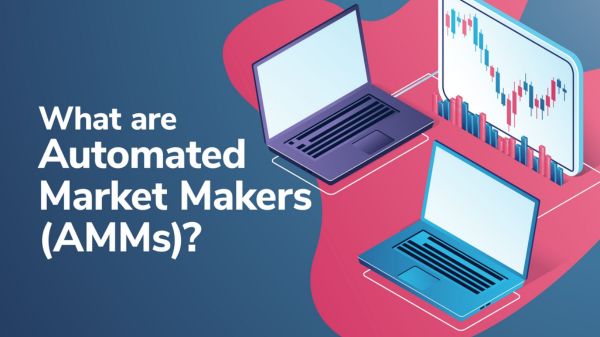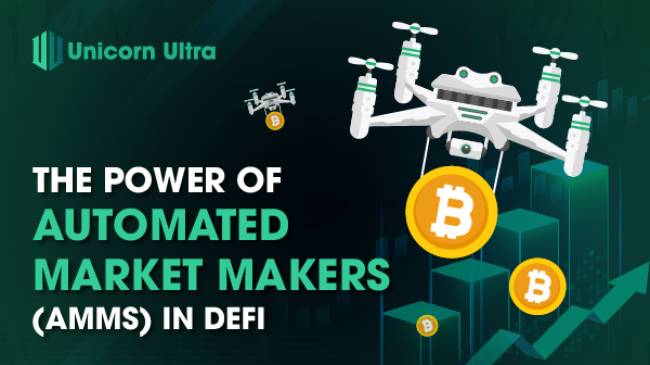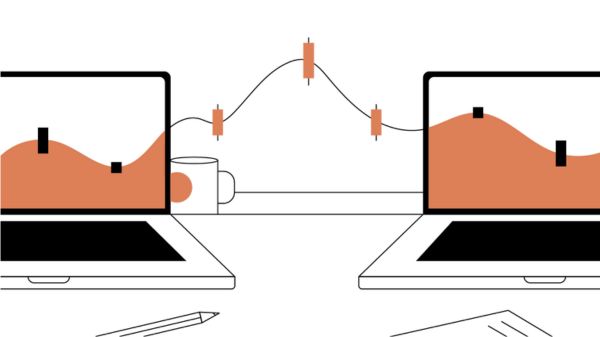Decentralized finance (DeFi) has revolutionized the financial landscape by enabling the creation of innovative and inclusive financial solutions. One such groundbreaking concept within DeFi is the automated market maker (AMM). AMMs have gained significant popularity and are now integral to many decentralized exchanges.
In this article, we will demystify what is an automated market maker, explore its inner workings, highlight its benefits, and understand the vital role liquidity providers play in its functioning.
Table of Contents
What is an Automated Market Maker (AMM)?
Automated market makers (AMMs) are decentralized exchanges employing algorithmic "money robots" to furnish liquidity to traders engaged in the buying and selling of cryptocurrency assets.
What is an automated market maker? Automated market makers (AMMs) represent a form of decentralized exchange (DEX) that employs algorithmic "money robots" to simplify the process of buying and selling cryptocurrencies for individual traders. Instead of engaging in direct trade with other individuals, as is the case with a traditional order book, users transact directly with the AMM.
Market makers are entities assigned with the responsibility of supplying liquidity to a tradable asset on an exchange that might otherwise suffer from low liquidity. They achieve this by buying and selling assets from their own accounts, aiming to generate profits, often by capitalizing on the spread—the difference between the highest buy offer and the lowest sell offer. Their trading activities contribute to the availability of liquidity, thereby mitigating the price impact of larger trades.
While various designs for decentralized exchanges (DEXs) exist, AMM-based DEXs have gained significant popularity, offering substantial liquidity for a wide array of digital tokens.

How does an Automated Market Maker (AMM) work?
AMMs rely on the concept of liquidity pools, which are pools of tokens locked in a smart contract. These pools enable users to trade tokens directly from the pool, rather than relying on order matching with other traders. The price of tokens in an AMM is determined based on a mathematical formula.
One of the most popular AMM algorithms is the constant product market maker, also known as the x*y=k formula. According to this formula, the product of the quantities of two tokens in a pool should remain constant. When a user swaps one token for another, the balance of each token in the pool is adjusted to maintain this equilibrium.
For example, if a user wants to swap Token A for Token B and there is a 50:50 ratio of these tokens in the pool, the AMM will adjust the quantities to maintain a constant product. If the user swaps a certain amount of Token A for Token B, the AMM will increase the quantity of Token A in the pool and decrease the quantity of Token B accordingly.

Benefits of an Automated Market Maker
In addition to facilitating liquidity for the operation of DEXs, AMMs offer several advantages to their users, as outlined below.
Reduces Barriers to Entry
Operating autonomously without the need for human intermediaries, AMMs enable anyone to engage in trading on a DEX protocol without the requirement for account verification or setup, provided they possess a crypto wallet. Users can also easily become liquidity providers, generating passive income through their contributions to the liquidity pool.
Enhances Clarity and Transparency
By enabling decentralized transactions on blockchains, AMMs enhance clarity and transparency for each automated trade, allowing users to maintain control over their digital assets during trading.
Facilitates Autonomous Trading
AMMs generally provide greater stability to users, as they do not necessitate direct asset swaps between traders for transactions to take place. Users can trade within the liquidity pool of digital assets, eliminating the need to wait for another trader to execute the trade.
Prevents Price Manipulation
Because trade automation is based on a formula and pricing algorithm, AMMs ensure fair and stable pricing of the digital assets involved in transactions. By maintaining the total value in the liquidity pool constant, they can prevent price manipulation tactics such as wash trading or front running.
The Role of Liquidity Providers in AMMs
Liquidity providers play a crucial role in the functioning of AMMs. They contribute to liquidity pools by depositing an equal value of both tokens in the pool. In return for their contribution, liquidity providers receive liquidity pool tokens, which represent their share of the pool.
Liquidity providers earn a portion of the trading fees generated by the AMM based on their share of the liquidity pool. This incentivizes liquidity provision and ensures that there is always liquidity available for traders.
However, being a liquidity provider also carries risks. Impermanent loss, which occurs when the value of tokens in the pool changes significantly compared to the time of deposit, can impact the profitability of liquidity provision.
Despite the risks, liquidity providers are vital to the stability and liquidity of AMMs. They enable the smooth functioning of decentralized exchanges and facilitate seamless trading activities.

Applications of Automated Market Maker
Automated Market Makers (AMMs) are a crucial component of decentralized exchanges (DEXs) and play a significant role in the world of decentralized finance (DeFi). AMMs provide an algorithmic mechanism for enabling liquidity and trading of assets without the need for traditional order books and centralized intermediaries. Here are some key applications of Automated Market Makers:
- Liquidity Provision: AMMs allow users to provide liquidity to the DEX by depositing pairs of assets into liquidity pools. Liquidity providers (LPs) are incentivized with trading fees and, in some cases, additional token rewards.
- Decentralized Exchange Trading: AMMs serve as the backbone of decentralized exchanges, enabling users to swap one asset for another directly on the blockchain without relying on a central authority.
- Token Swaps: Traders can use AMMs to swap tokens instantly, as long as there is sufficient liquidity in the relevant liquidity pool.
- Token Listings: New tokens can be listed on AMMs with minimal effort, making it easier for developers to bootstrap liquidity for their tokens.
- Price Oracle: Some AMMs are used as price oracles to provide reliable on-chain price data for other DeFi applications.
- Stablecoin Pairs: Stablecoins can be paired with volatile assets in AMMs, creating stablecoin trading pairs with minimal slippage.
- Flash Loans: Some DeFi protocols utilize AMMs to facilitate flash loans, allowing users to borrow assets without collateral, provided they return the borrowed assets within the same transaction.
- Farming and Yield Strategies: Yield farmers leverage AMMs to execute complex strategies involving multiple liquidity pools to maximize their returns.
- Automated Portfolio Management: Some platforms use AMMs to manage portfolio assets automatically, rebalancing and adjusting token weights based on predefined criteria.
- Synthetic Asset Creation: AMMs can be used in the creation of synthetic assets, where an ERC-20 token represents the price of an external asset, enabling users to trade the synthetic token on-chain without holding the actual asset.
- Prediction Markets: AMMs can be applied in prediction markets, allowing users to trade shares representing their beliefs on the outcome of a specific event.
It's essential to note that while AMMs have brought significant innovations to DeFi, they also have limitations, such as impermanent loss for liquidity providers and potential price slippage during large trades. As the DeFi ecosystem evolves, AMMs are likely to continue to play a critical role in providing decentralized liquidity and enabling a wide range of innovative financial applications.
Conclusion
By knowing what is an automated market maker, we could state that automated market makers have transformed decentralized finance by providing efficient, accessible, and liquid trading environments. These innovative protocols have simplified the trading process and empowered users to participate in the decentralized economy. As AMMs continue to evolve and gain adoption, they are likely to play a crucial role in shaping the future of finance, promoting financial inclusion, and driving innovation in the decentralized ecosystem. Follow https://uniultra.xyz/ for more crypto investment updates.






